Research Methods in Management: Analysis of AI in Business Articles
VerifiedAdded on 2022/11/23
|19
|2954
|106
Report
AI Summary
This report analyzes the impact of artificial intelligence (AI) across various sectors, including finance, banking, and healthcare, focusing on its influence on individual feelings, jobs, and skills. The study, based on a literature review of 10 articles, investigates the methodologies used in AI research and presents findings through tables and graphs. The research questions explore how AI affects individual feelings, job roles, and skill sets, as well as the relationships between different sectors. The analysis includes data from the reviewed articles, categorized by author, number of pages, references, and country of affiliation. The research employs methods such as questionnaires, interviews, and data analysis techniques, including deep analysis, content analysis, and regression analysis. Results from the study, including p-values from ANOVA tests, suggest a significant impact of AI on feelings, job roles, and skills, along with variations among different sectors. Recommendations from the articles are categorized and presented in a 3D pie chart, offering insights for future research and practical applications in business management. The report concludes by emphasizing the varied effects of AI on skills and the importance of considering ethical aspects of AI implementation.
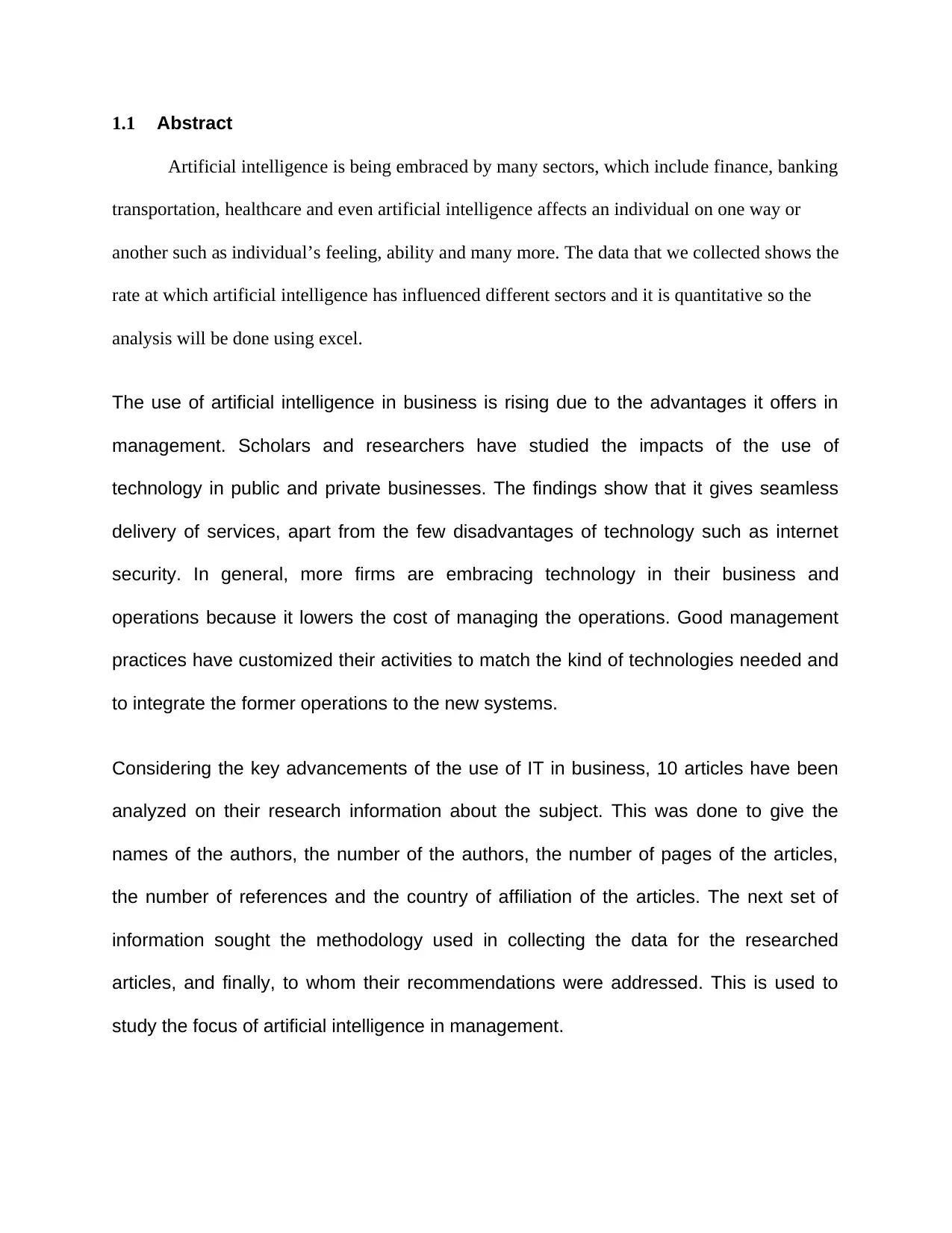
1.1 Abstract
Artificial intelligence is being embraced by many sectors, which include finance, banking
transportation, healthcare and even artificial intelligence affects an individual on one way or
another such as individual’s feeling, ability and many more. The data that we collected shows the
rate at which artificial intelligence has influenced different sectors and it is quantitative so the
analysis will be done using excel.
The use of artificial intelligence in business is rising due to the advantages it offers in
management. Scholars and researchers have studied the impacts of the use of
technology in public and private businesses. The findings show that it gives seamless
delivery of services, apart from the few disadvantages of technology such as internet
security. In general, more firms are embracing technology in their business and
operations because it lowers the cost of managing the operations. Good management
practices have customized their activities to match the kind of technologies needed and
to integrate the former operations to the new systems.
Considering the key advancements of the use of IT in business, 10 articles have been
analyzed on their research information about the subject. This was done to give the
names of the authors, the number of the authors, the number of pages of the articles,
the number of references and the country of affiliation of the articles. The next set of
information sought the methodology used in collecting the data for the researched
articles, and finally, to whom their recommendations were addressed. This is used to
study the focus of artificial intelligence in management.
Artificial intelligence is being embraced by many sectors, which include finance, banking
transportation, healthcare and even artificial intelligence affects an individual on one way or
another such as individual’s feeling, ability and many more. The data that we collected shows the
rate at which artificial intelligence has influenced different sectors and it is quantitative so the
analysis will be done using excel.
The use of artificial intelligence in business is rising due to the advantages it offers in
management. Scholars and researchers have studied the impacts of the use of
technology in public and private businesses. The findings show that it gives seamless
delivery of services, apart from the few disadvantages of technology such as internet
security. In general, more firms are embracing technology in their business and
operations because it lowers the cost of managing the operations. Good management
practices have customized their activities to match the kind of technologies needed and
to integrate the former operations to the new systems.
Considering the key advancements of the use of IT in business, 10 articles have been
analyzed on their research information about the subject. This was done to give the
names of the authors, the number of the authors, the number of pages of the articles,
the number of references and the country of affiliation of the articles. The next set of
information sought the methodology used in collecting the data for the researched
articles, and finally, to whom their recommendations were addressed. This is used to
study the focus of artificial intelligence in management.
Paraphrase This Document
Need a fresh take? Get an instant paraphrase of this document with our AI Paraphraser
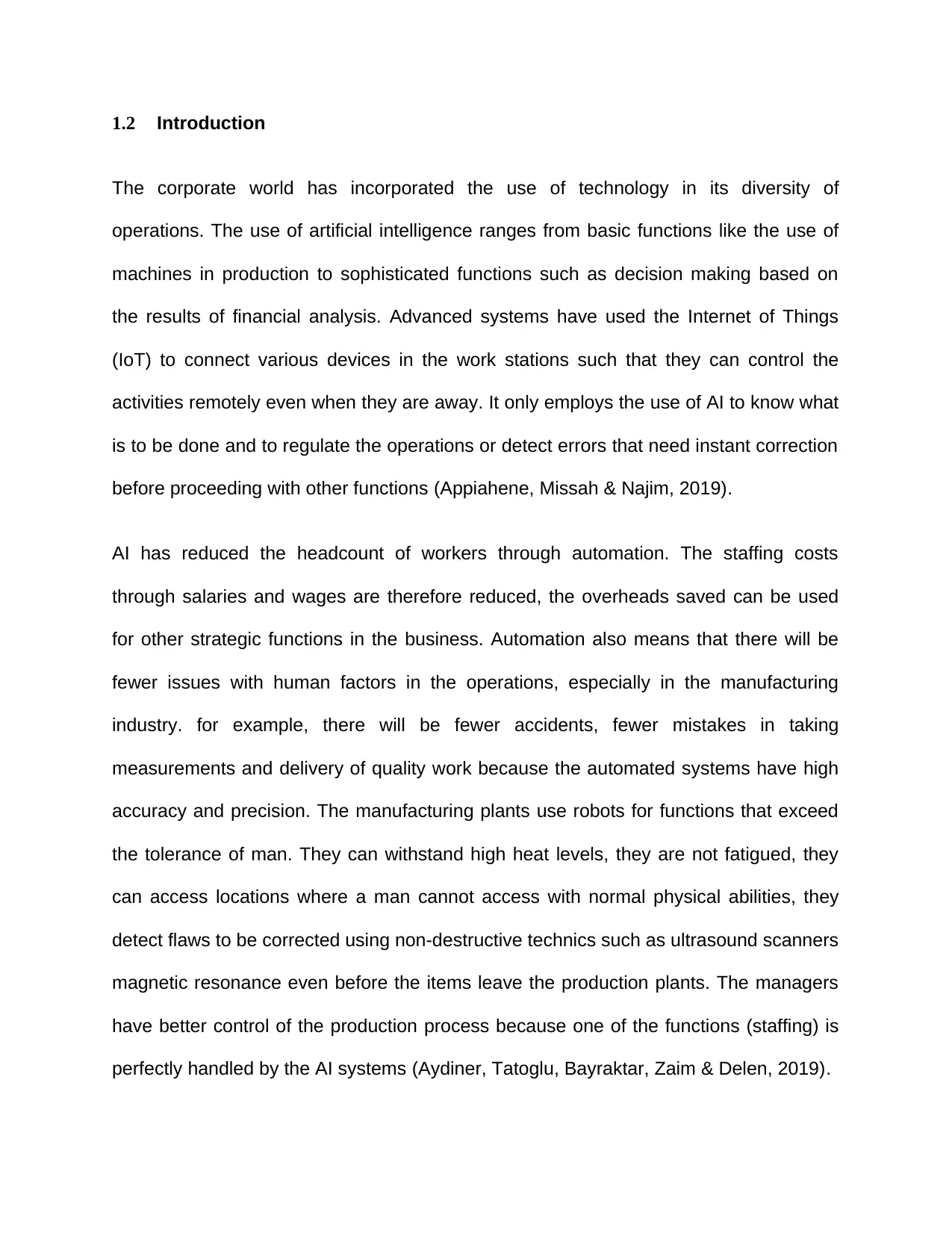
1.2 Introduction
The corporate world has incorporated the use of technology in its diversity of
operations. The use of artificial intelligence ranges from basic functions like the use of
machines in production to sophisticated functions such as decision making based on
the results of financial analysis. Advanced systems have used the Internet of Things
(IoT) to connect various devices in the work stations such that they can control the
activities remotely even when they are away. It only employs the use of AI to know what
is to be done and to regulate the operations or detect errors that need instant correction
before proceeding with other functions (Appiahene, Missah & Najim, 2019).
AI has reduced the headcount of workers through automation. The staffing costs
through salaries and wages are therefore reduced, the overheads saved can be used
for other strategic functions in the business. Automation also means that there will be
fewer issues with human factors in the operations, especially in the manufacturing
industry. for example, there will be fewer accidents, fewer mistakes in taking
measurements and delivery of quality work because the automated systems have high
accuracy and precision. The manufacturing plants use robots for functions that exceed
the tolerance of man. They can withstand high heat levels, they are not fatigued, they
can access locations where a man cannot access with normal physical abilities, they
detect flaws to be corrected using non-destructive technics such as ultrasound scanners
magnetic resonance even before the items leave the production plants. The managers
have better control of the production process because one of the functions (staffing) is
perfectly handled by the AI systems (Aydiner, Tatoglu, Bayraktar, Zaim & Delen, 2019).
The corporate world has incorporated the use of technology in its diversity of
operations. The use of artificial intelligence ranges from basic functions like the use of
machines in production to sophisticated functions such as decision making based on
the results of financial analysis. Advanced systems have used the Internet of Things
(IoT) to connect various devices in the work stations such that they can control the
activities remotely even when they are away. It only employs the use of AI to know what
is to be done and to regulate the operations or detect errors that need instant correction
before proceeding with other functions (Appiahene, Missah & Najim, 2019).
AI has reduced the headcount of workers through automation. The staffing costs
through salaries and wages are therefore reduced, the overheads saved can be used
for other strategic functions in the business. Automation also means that there will be
fewer issues with human factors in the operations, especially in the manufacturing
industry. for example, there will be fewer accidents, fewer mistakes in taking
measurements and delivery of quality work because the automated systems have high
accuracy and precision. The manufacturing plants use robots for functions that exceed
the tolerance of man. They can withstand high heat levels, they are not fatigued, they
can access locations where a man cannot access with normal physical abilities, they
detect flaws to be corrected using non-destructive technics such as ultrasound scanners
magnetic resonance even before the items leave the production plants. The managers
have better control of the production process because one of the functions (staffing) is
perfectly handled by the AI systems (Aydiner, Tatoglu, Bayraktar, Zaim & Delen, 2019).
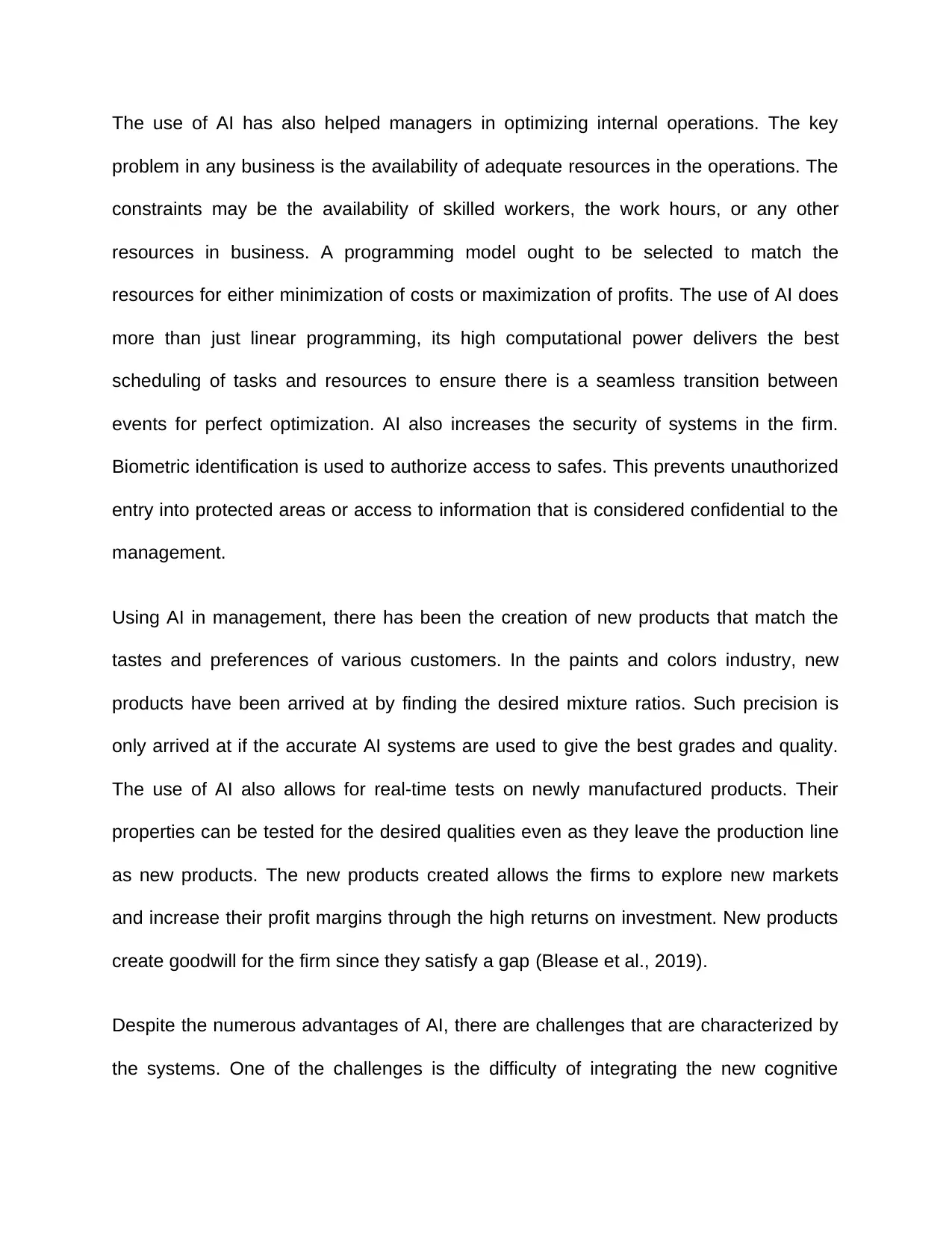
The use of AI has also helped managers in optimizing internal operations. The key
problem in any business is the availability of adequate resources in the operations. The
constraints may be the availability of skilled workers, the work hours, or any other
resources in business. A programming model ought to be selected to match the
resources for either minimization of costs or maximization of profits. The use of AI does
more than just linear programming, its high computational power delivers the best
scheduling of tasks and resources to ensure there is a seamless transition between
events for perfect optimization. AI also increases the security of systems in the firm.
Biometric identification is used to authorize access to safes. This prevents unauthorized
entry into protected areas or access to information that is considered confidential to the
management.
Using AI in management, there has been the creation of new products that match the
tastes and preferences of various customers. In the paints and colors industry, new
products have been arrived at by finding the desired mixture ratios. Such precision is
only arrived at if the accurate AI systems are used to give the best grades and quality.
The use of AI also allows for real-time tests on newly manufactured products. Their
properties can be tested for the desired qualities even as they leave the production line
as new products. The new products created allows the firms to explore new markets
and increase their profit margins through the high returns on investment. New products
create goodwill for the firm since they satisfy a gap (Blease et al., 2019).
Despite the numerous advantages of AI, there are challenges that are characterized by
the systems. One of the challenges is the difficulty of integrating the new cognitive
problem in any business is the availability of adequate resources in the operations. The
constraints may be the availability of skilled workers, the work hours, or any other
resources in business. A programming model ought to be selected to match the
resources for either minimization of costs or maximization of profits. The use of AI does
more than just linear programming, its high computational power delivers the best
scheduling of tasks and resources to ensure there is a seamless transition between
events for perfect optimization. AI also increases the security of systems in the firm.
Biometric identification is used to authorize access to safes. This prevents unauthorized
entry into protected areas or access to information that is considered confidential to the
management.
Using AI in management, there has been the creation of new products that match the
tastes and preferences of various customers. In the paints and colors industry, new
products have been arrived at by finding the desired mixture ratios. Such precision is
only arrived at if the accurate AI systems are used to give the best grades and quality.
The use of AI also allows for real-time tests on newly manufactured products. Their
properties can be tested for the desired qualities even as they leave the production line
as new products. The new products created allows the firms to explore new markets
and increase their profit margins through the high returns on investment. New products
create goodwill for the firm since they satisfy a gap (Blease et al., 2019).
Despite the numerous advantages of AI, there are challenges that are characterized by
the systems. One of the challenges is the difficulty of integrating the new cognitive
⊘ This is a preview!⊘
Do you want full access?
Subscribe today to unlock all pages.

Trusted by 1+ million students worldwide
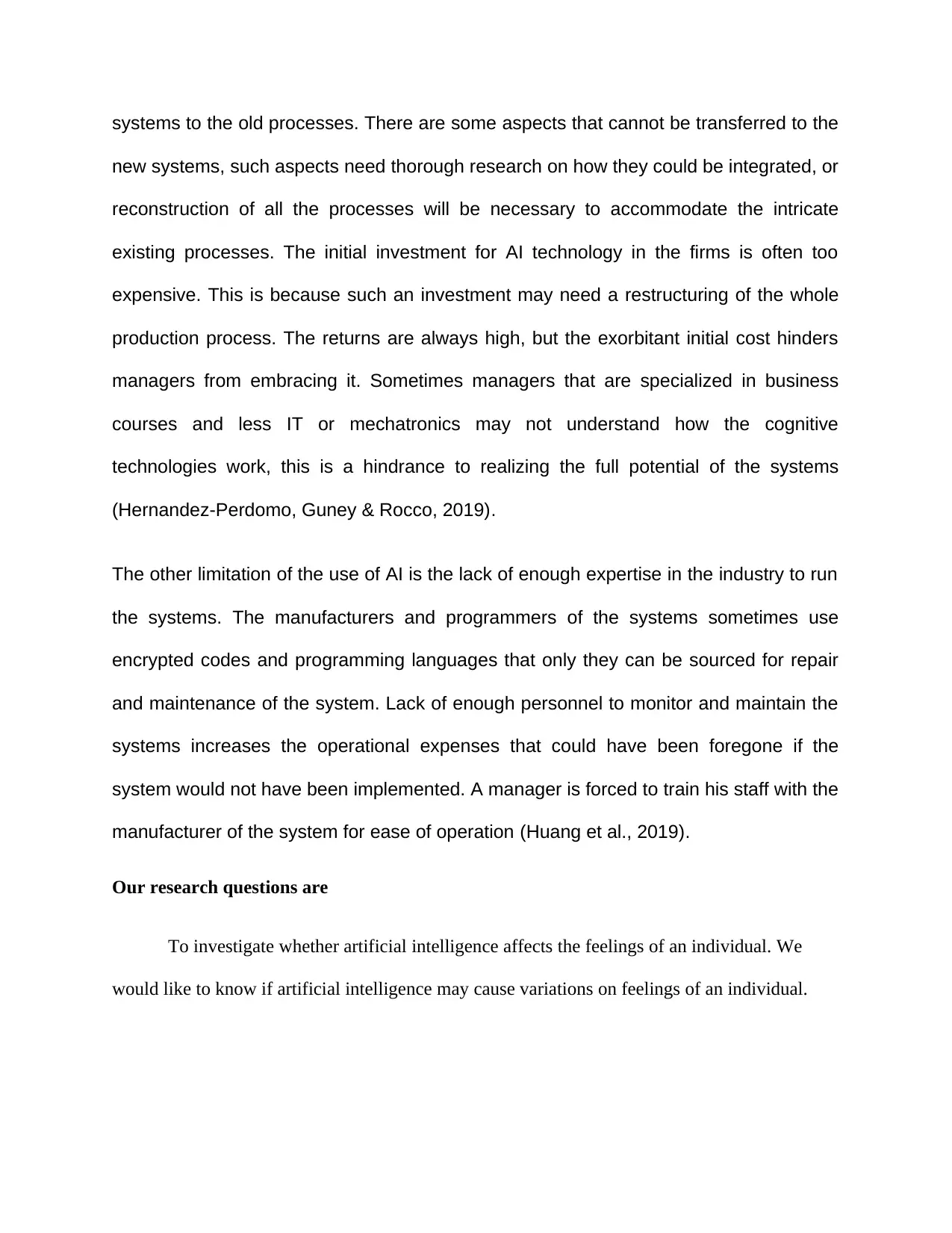
systems to the old processes. There are some aspects that cannot be transferred to the
new systems, such aspects need thorough research on how they could be integrated, or
reconstruction of all the processes will be necessary to accommodate the intricate
existing processes. The initial investment for AI technology in the firms is often too
expensive. This is because such an investment may need a restructuring of the whole
production process. The returns are always high, but the exorbitant initial cost hinders
managers from embracing it. Sometimes managers that are specialized in business
courses and less IT or mechatronics may not understand how the cognitive
technologies work, this is a hindrance to realizing the full potential of the systems
(Hernandez-Perdomo, Guney & Rocco, 2019).
The other limitation of the use of AI is the lack of enough expertise in the industry to run
the systems. The manufacturers and programmers of the systems sometimes use
encrypted codes and programming languages that only they can be sourced for repair
and maintenance of the system. Lack of enough personnel to monitor and maintain the
systems increases the operational expenses that could have been foregone if the
system would not have been implemented. A manager is forced to train his staff with the
manufacturer of the system for ease of operation (Huang et al., 2019).
Our research questions are
To investigate whether artificial intelligence affects the feelings of an individual. We
would like to know if artificial intelligence may cause variations on feelings of an individual.
new systems, such aspects need thorough research on how they could be integrated, or
reconstruction of all the processes will be necessary to accommodate the intricate
existing processes. The initial investment for AI technology in the firms is often too
expensive. This is because such an investment may need a restructuring of the whole
production process. The returns are always high, but the exorbitant initial cost hinders
managers from embracing it. Sometimes managers that are specialized in business
courses and less IT or mechatronics may not understand how the cognitive
technologies work, this is a hindrance to realizing the full potential of the systems
(Hernandez-Perdomo, Guney & Rocco, 2019).
The other limitation of the use of AI is the lack of enough expertise in the industry to run
the systems. The manufacturers and programmers of the systems sometimes use
encrypted codes and programming languages that only they can be sourced for repair
and maintenance of the system. Lack of enough personnel to monitor and maintain the
systems increases the operational expenses that could have been foregone if the
system would not have been implemented. A manager is forced to train his staff with the
manufacturer of the system for ease of operation (Huang et al., 2019).
Our research questions are
To investigate whether artificial intelligence affects the feelings of an individual. We
would like to know if artificial intelligence may cause variations on feelings of an individual.
Paraphrase This Document
Need a fresh take? Get an instant paraphrase of this document with our AI Paraphraser
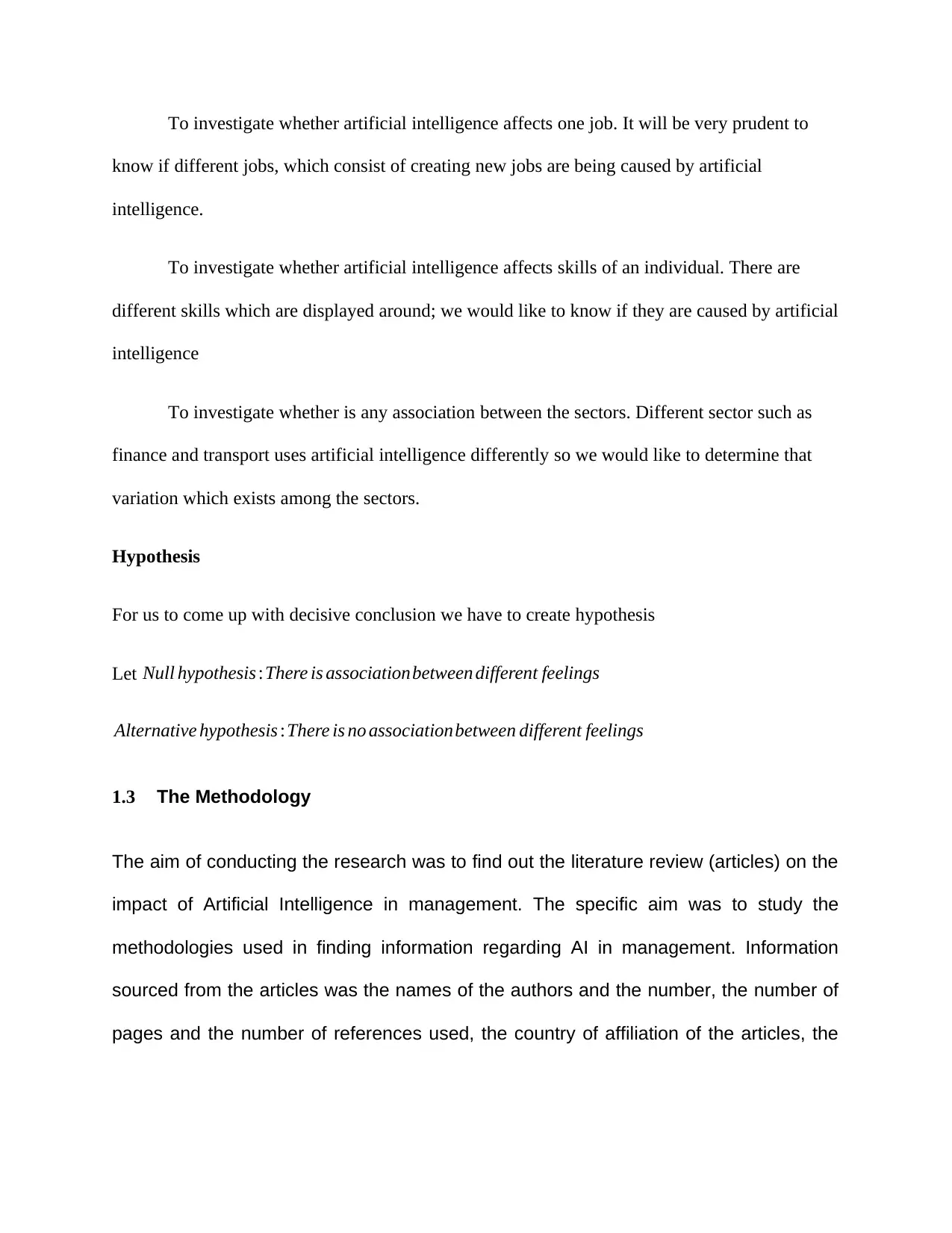
To investigate whether artificial intelligence affects one job. It will be very prudent to
know if different jobs, which consist of creating new jobs are being caused by artificial
intelligence.
To investigate whether artificial intelligence affects skills of an individual. There are
different skills which are displayed around; we would like to know if they are caused by artificial
intelligence
To investigate whether is any association between the sectors. Different sector such as
finance and transport uses artificial intelligence differently so we would like to determine that
variation which exists among the sectors.
Hypothesis
For us to come up with decisive conclusion we have to create hypothesis
Let Null hypothesis :There is associationbetween different feelings
Alternative hypothesis :There is no associationbetween different feelings
1.3 The Methodology
The aim of conducting the research was to find out the literature review (articles) on the
impact of Artificial Intelligence in management. The specific aim was to study the
methodologies used in finding information regarding AI in management. Information
sourced from the articles was the names of the authors and the number, the number of
pages and the number of references used, the country of affiliation of the articles, the
know if different jobs, which consist of creating new jobs are being caused by artificial
intelligence.
To investigate whether artificial intelligence affects skills of an individual. There are
different skills which are displayed around; we would like to know if they are caused by artificial
intelligence
To investigate whether is any association between the sectors. Different sector such as
finance and transport uses artificial intelligence differently so we would like to determine that
variation which exists among the sectors.
Hypothesis
For us to come up with decisive conclusion we have to create hypothesis
Let Null hypothesis :There is associationbetween different feelings
Alternative hypothesis :There is no associationbetween different feelings
1.3 The Methodology
The aim of conducting the research was to find out the literature review (articles) on the
impact of Artificial Intelligence in management. The specific aim was to study the
methodologies used in finding information regarding AI in management. Information
sourced from the articles was the names of the authors and the number, the number of
pages and the number of references used, the country of affiliation of the articles, the
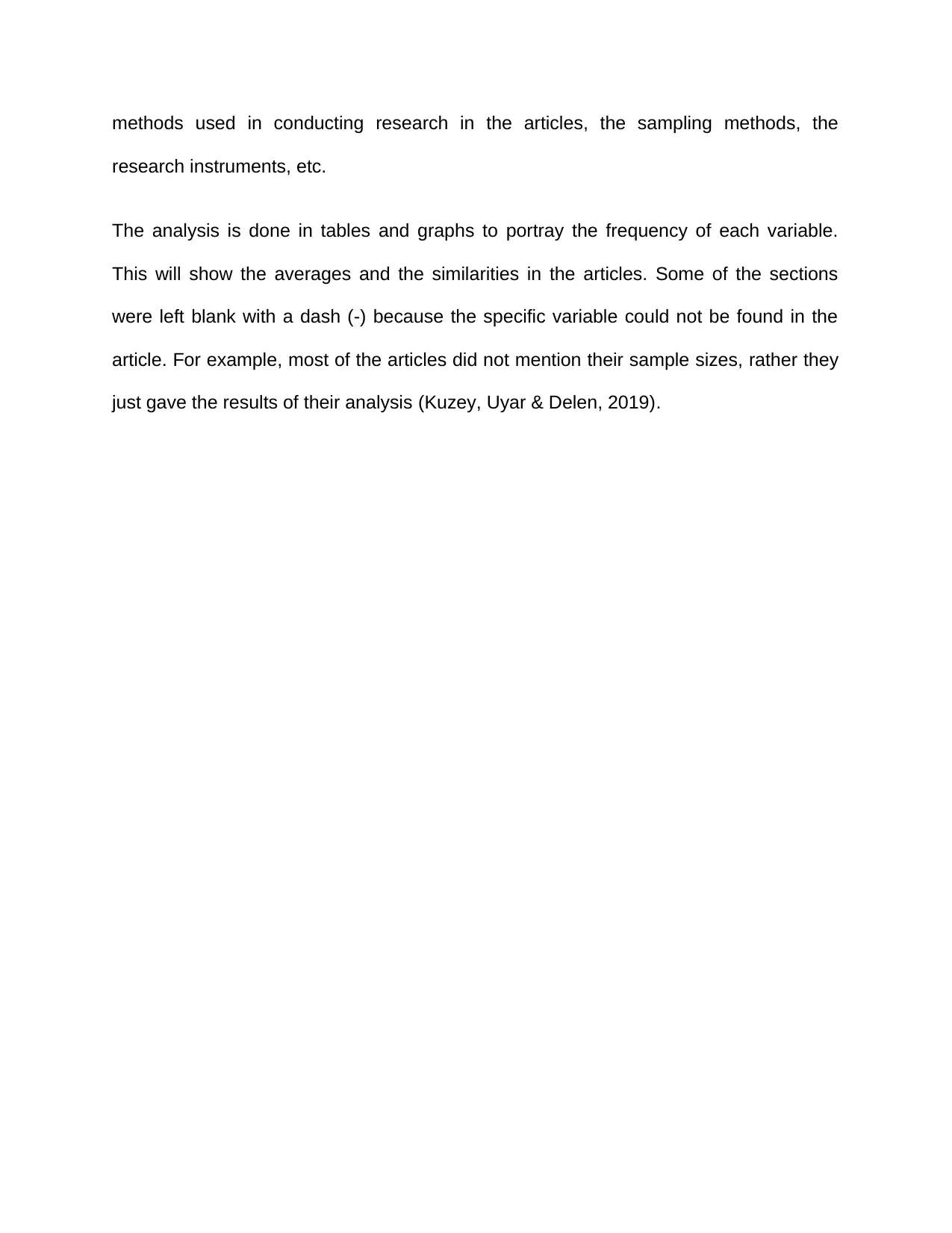
methods used in conducting research in the articles, the sampling methods, the
research instruments, etc.
The analysis is done in tables and graphs to portray the frequency of each variable.
This will show the averages and the similarities in the articles. Some of the sections
were left blank with a dash (-) because the specific variable could not be found in the
article. For example, most of the articles did not mention their sample sizes, rather they
just gave the results of their analysis (Kuzey, Uyar & Delen, 2019).
research instruments, etc.
The analysis is done in tables and graphs to portray the frequency of each variable.
This will show the averages and the similarities in the articles. Some of the sections
were left blank with a dash (-) because the specific variable could not be found in the
article. For example, most of the articles did not mention their sample sizes, rather they
just gave the results of their analysis (Kuzey, Uyar & Delen, 2019).
⊘ This is a preview!⊘
Do you want full access?
Subscribe today to unlock all pages.

Trusted by 1+ million students worldwide
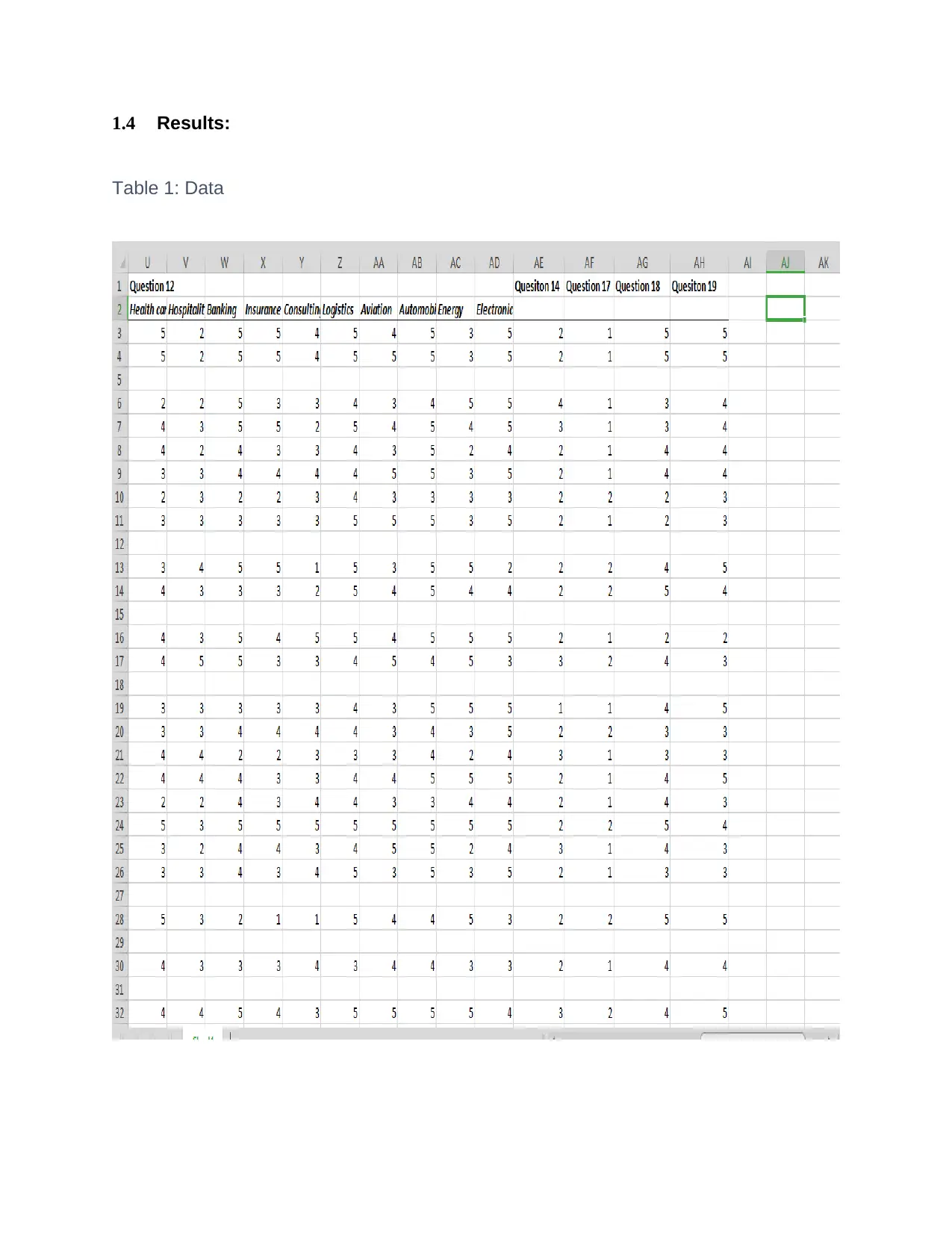
1.4 Results:
Table 1: Data
Table 1: Data
Paraphrase This Document
Need a fresh take? Get an instant paraphrase of this document with our AI Paraphraser
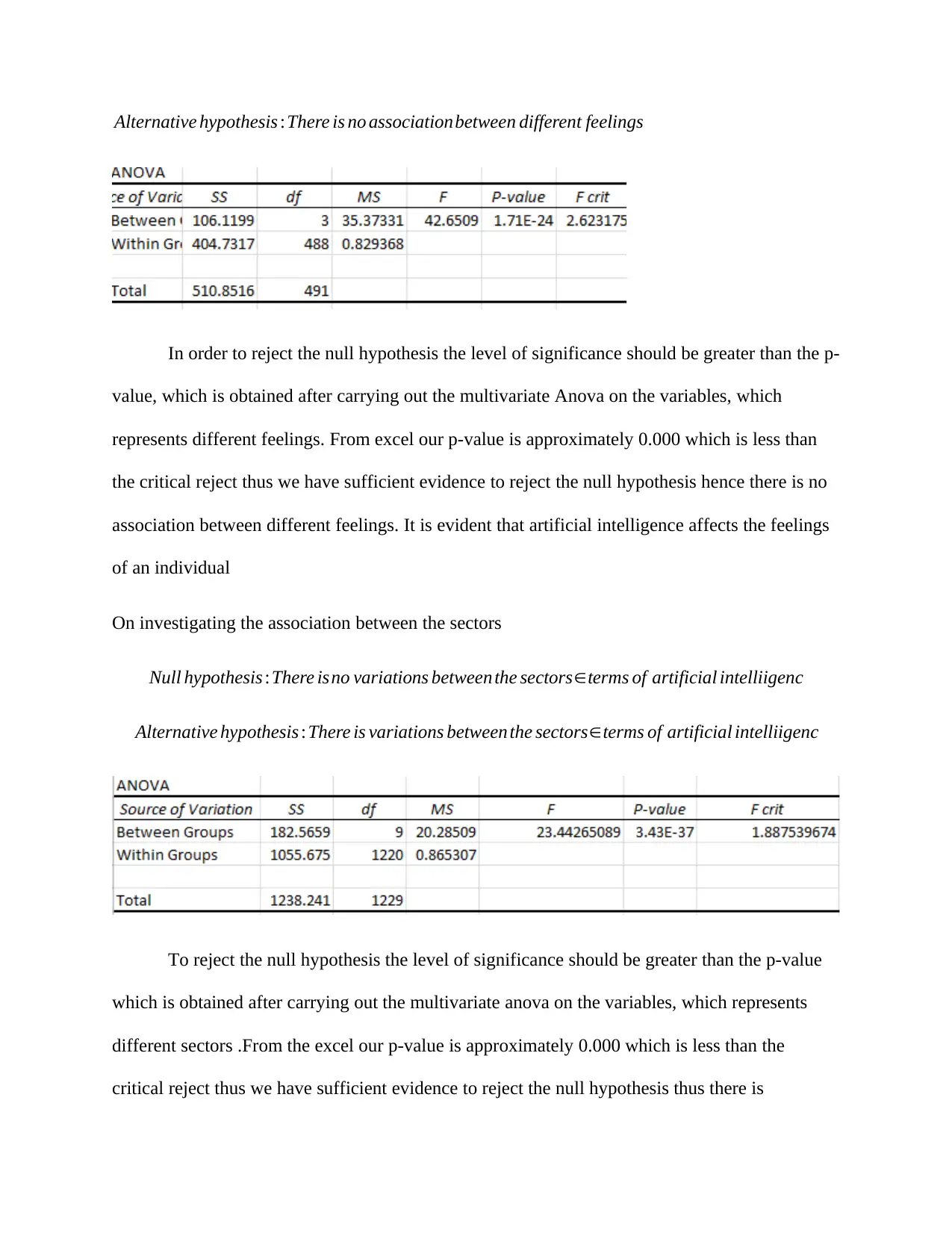
Alternative hypothesis :There is no associationbetween different feelings
In order to reject the null hypothesis the level of significance should be greater than the p-
value, which is obtained after carrying out the multivariate Anova on the variables, which
represents different feelings. From excel our p-value is approximately 0.000 which is less than
the critical reject thus we have sufficient evidence to reject the null hypothesis hence there is no
association between different feelings. It is evident that artificial intelligence affects the feelings
of an individual
On investigating the association between the sectors
Null hypothesis :There isno variations between the sectors∈terms of artificial intelliigenc
Alternative hypothesis :There is variations between the sectors∈terms of artificial intelliigenc
To reject the null hypothesis the level of significance should be greater than the p-value
which is obtained after carrying out the multivariate anova on the variables, which represents
different sectors .From the excel our p-value is approximately 0.000 which is less than the
critical reject thus we have sufficient evidence to reject the null hypothesis thus there is
In order to reject the null hypothesis the level of significance should be greater than the p-
value, which is obtained after carrying out the multivariate Anova on the variables, which
represents different feelings. From excel our p-value is approximately 0.000 which is less than
the critical reject thus we have sufficient evidence to reject the null hypothesis hence there is no
association between different feelings. It is evident that artificial intelligence affects the feelings
of an individual
On investigating the association between the sectors
Null hypothesis :There isno variations between the sectors∈terms of artificial intelliigenc
Alternative hypothesis :There is variations between the sectors∈terms of artificial intelliigenc
To reject the null hypothesis the level of significance should be greater than the p-value
which is obtained after carrying out the multivariate anova on the variables, which represents
different sectors .From the excel our p-value is approximately 0.000 which is less than the
critical reject thus we have sufficient evidence to reject the null hypothesis thus there is
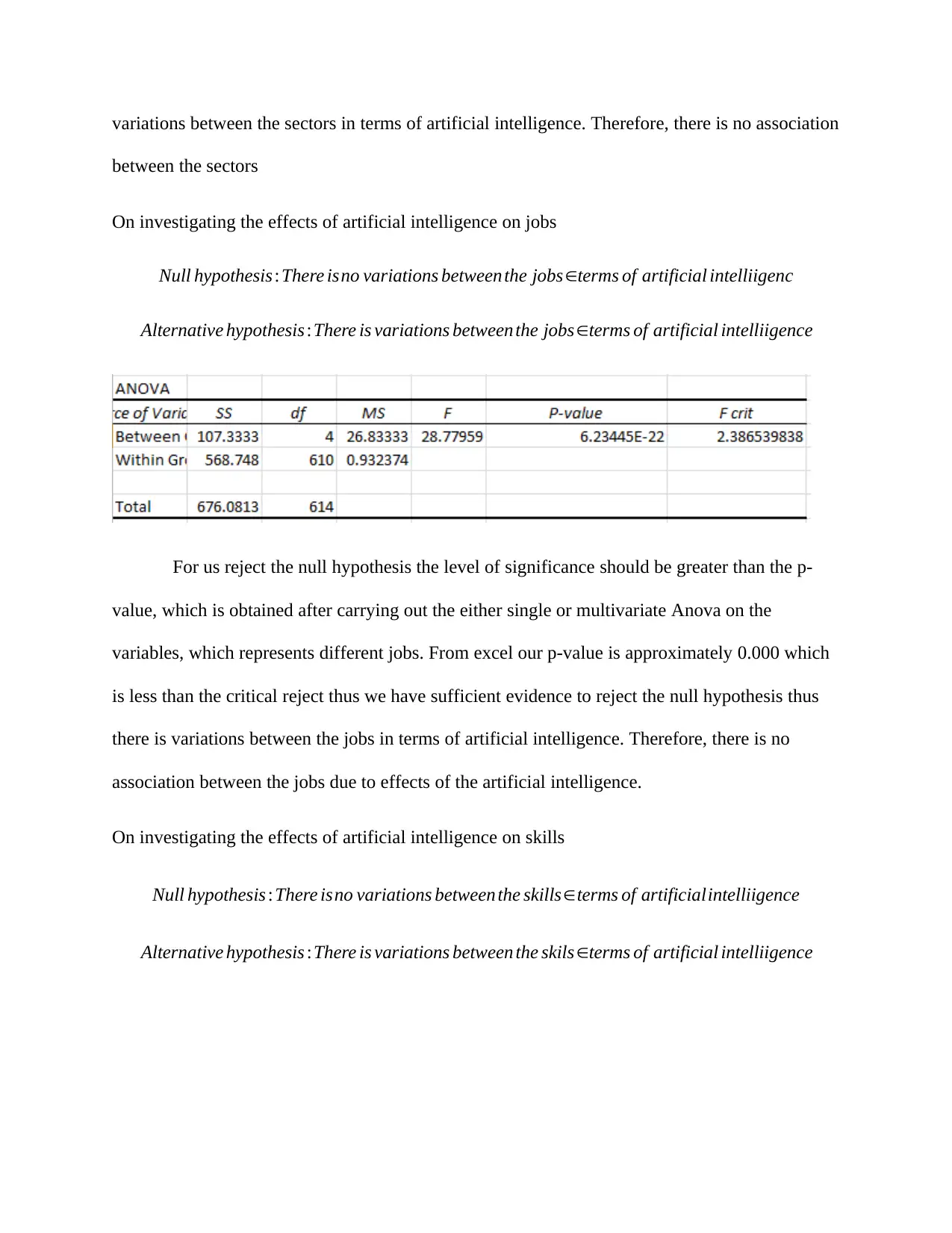
variations between the sectors in terms of artificial intelligence. Therefore, there is no association
between the sectors
On investigating the effects of artificial intelligence on jobs
Null hypothesis :There isno variations between the jobs∈terms of artificial intelliigenc
Alternative hypothesis :There is variations between the jobs∈terms of artificial intelliigence
For us reject the null hypothesis the level of significance should be greater than the p-
value, which is obtained after carrying out the either single or multivariate Anova on the
variables, which represents different jobs. From excel our p-value is approximately 0.000 which
is less than the critical reject thus we have sufficient evidence to reject the null hypothesis thus
there is variations between the jobs in terms of artificial intelligence. Therefore, there is no
association between the jobs due to effects of the artificial intelligence.
On investigating the effects of artificial intelligence on skills
Null hypothesis :There isno variations between the skills∈terms of artificialintelliigence
Alternative hypothesis :There is variations between the skils ∈terms of artificial intelliigence
between the sectors
On investigating the effects of artificial intelligence on jobs
Null hypothesis :There isno variations between the jobs∈terms of artificial intelliigenc
Alternative hypothesis :There is variations between the jobs∈terms of artificial intelliigence
For us reject the null hypothesis the level of significance should be greater than the p-
value, which is obtained after carrying out the either single or multivariate Anova on the
variables, which represents different jobs. From excel our p-value is approximately 0.000 which
is less than the critical reject thus we have sufficient evidence to reject the null hypothesis thus
there is variations between the jobs in terms of artificial intelligence. Therefore, there is no
association between the jobs due to effects of the artificial intelligence.
On investigating the effects of artificial intelligence on skills
Null hypothesis :There isno variations between the skills∈terms of artificialintelliigence
Alternative hypothesis :There is variations between the skils ∈terms of artificial intelliigence
⊘ This is a preview!⊘
Do you want full access?
Subscribe today to unlock all pages.

Trusted by 1+ million students worldwide
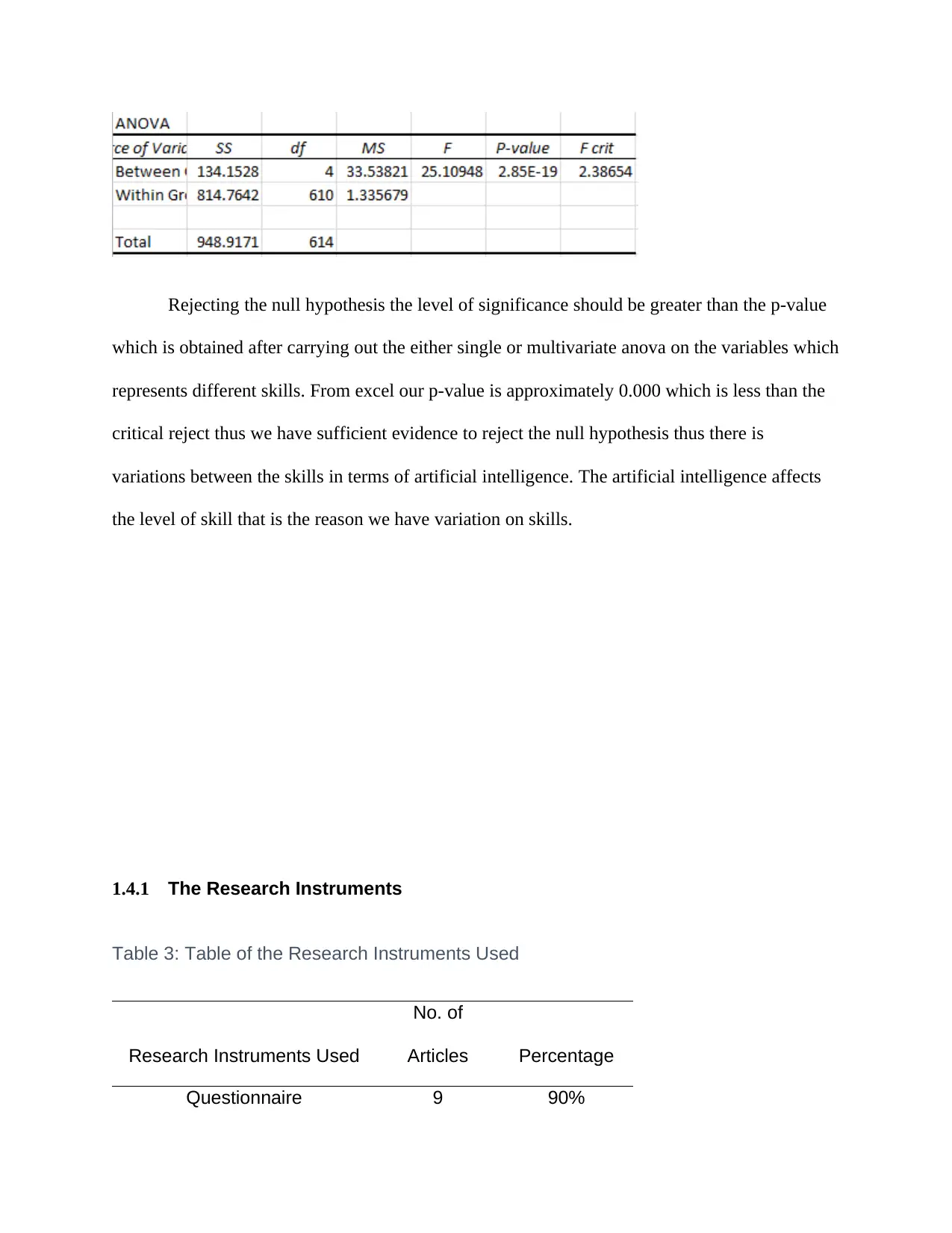
Rejecting the null hypothesis the level of significance should be greater than the p-value
which is obtained after carrying out the either single or multivariate anova on the variables which
represents different skills. From excel our p-value is approximately 0.000 which is less than the
critical reject thus we have sufficient evidence to reject the null hypothesis thus there is
variations between the skills in terms of artificial intelligence. The artificial intelligence affects
the level of skill that is the reason we have variation on skills.
1.4.1 The Research Instruments
Table 3: Table of the Research Instruments Used
Research Instruments Used
No. of
Articles Percentage
Questionnaire 9 90%
which is obtained after carrying out the either single or multivariate anova on the variables which
represents different skills. From excel our p-value is approximately 0.000 which is less than the
critical reject thus we have sufficient evidence to reject the null hypothesis thus there is
variations between the skills in terms of artificial intelligence. The artificial intelligence affects
the level of skill that is the reason we have variation on skills.
1.4.1 The Research Instruments
Table 3: Table of the Research Instruments Used
Research Instruments Used
No. of
Articles Percentage
Questionnaire 9 90%
Paraphrase This Document
Need a fresh take? Get an instant paraphrase of this document with our AI Paraphraser
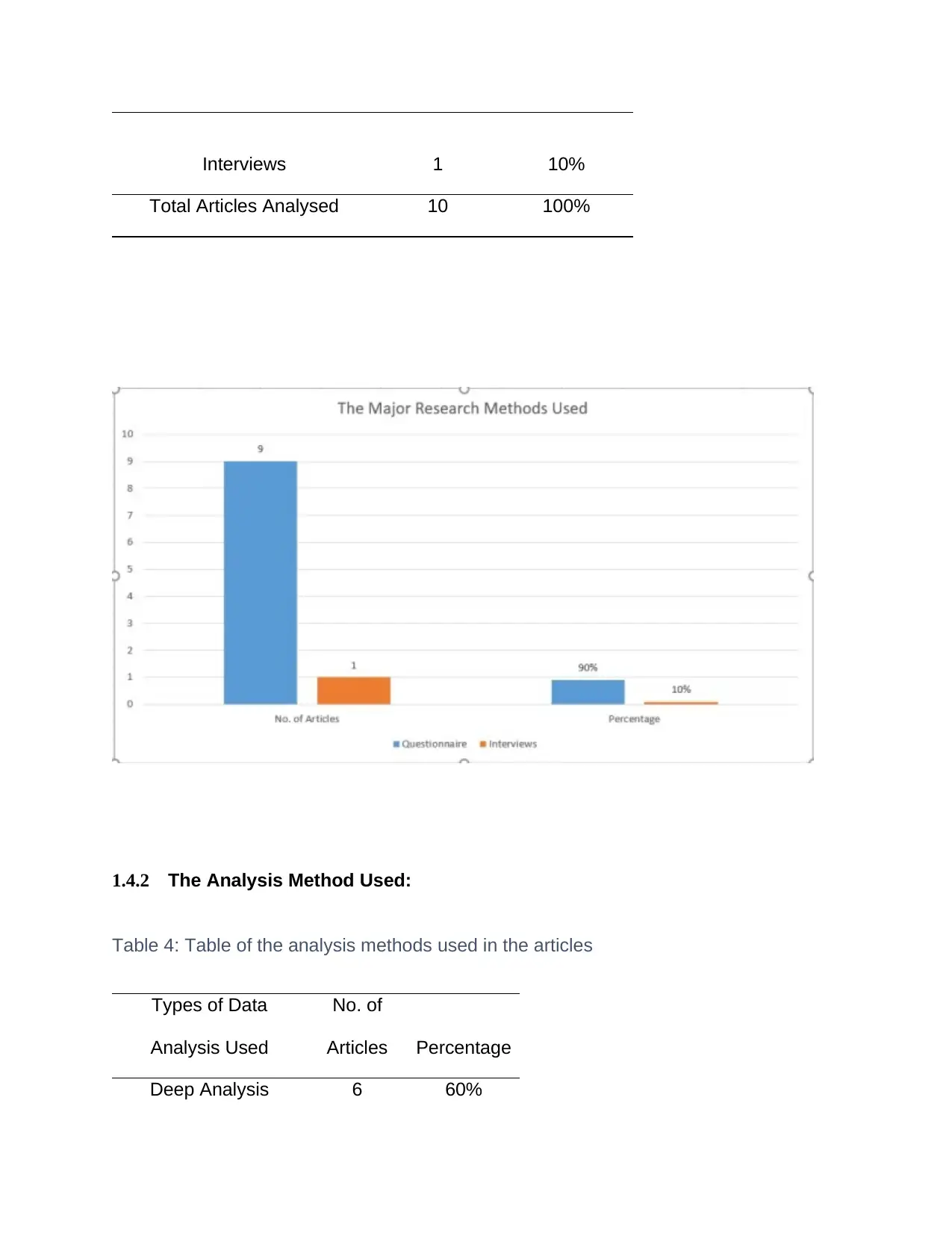
Interviews 1 10%
Total Articles Analysed 10 100%
1.4.2 The Analysis Method Used:
Table 4: Table of the analysis methods used in the articles
Types of Data
Analysis Used
No. of
Articles Percentage
Deep Analysis 6 60%
Total Articles Analysed 10 100%
1.4.2 The Analysis Method Used:
Table 4: Table of the analysis methods used in the articles
Types of Data
Analysis Used
No. of
Articles Percentage
Deep Analysis 6 60%
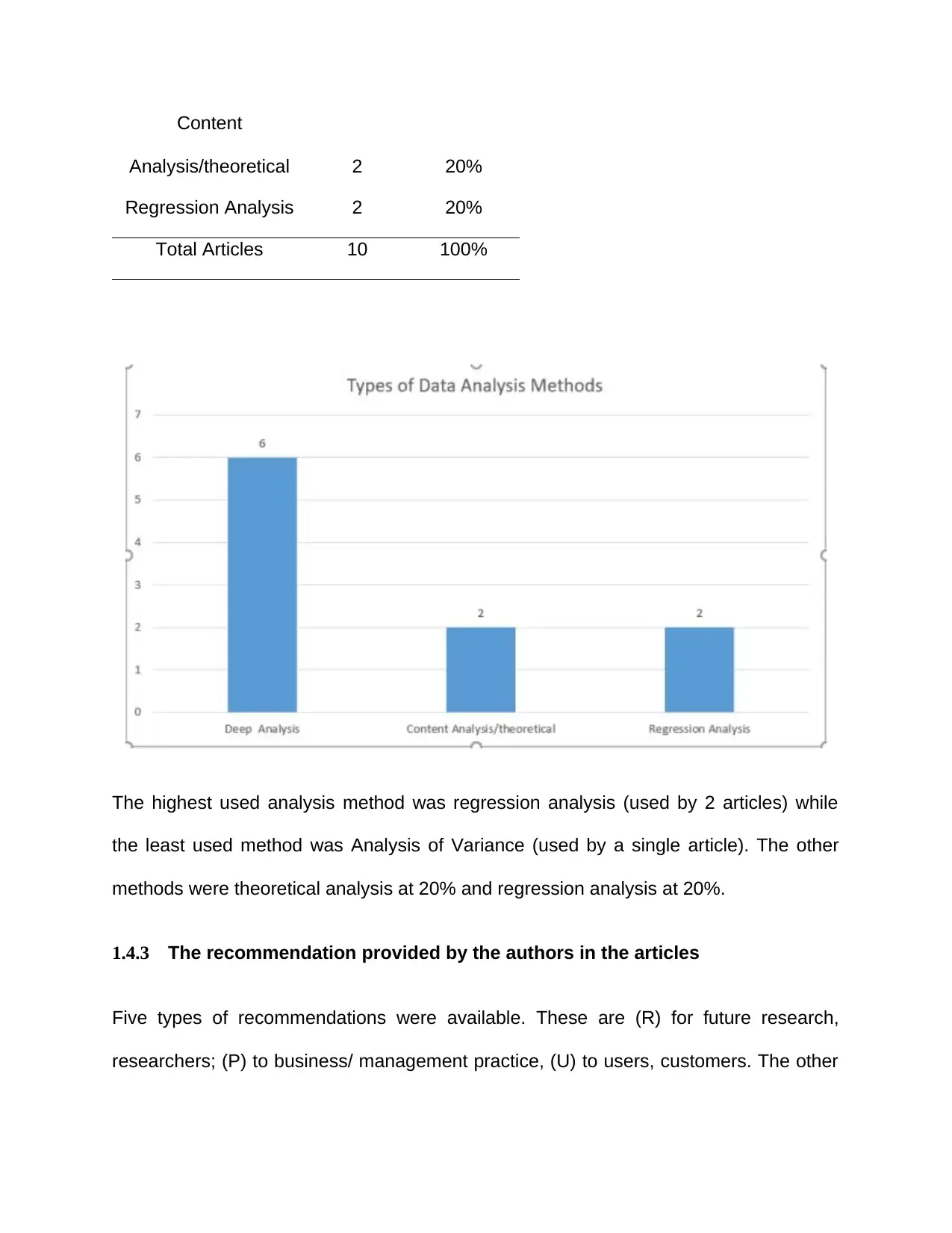
Content
Analysis/theoretical 2 20%
Regression Analysis 2 20%
Total Articles 10 100%
The highest used analysis method was regression analysis (used by 2 articles) while
the least used method was Analysis of Variance (used by a single article). The other
methods were theoretical analysis at 20% and regression analysis at 20%.
1.4.3 The recommendation provided by the authors in the articles
Five types of recommendations were available. These are (R) for future research,
researchers; (P) to business/ management practice, (U) to users, customers. The other
Analysis/theoretical 2 20%
Regression Analysis 2 20%
Total Articles 10 100%
The highest used analysis method was regression analysis (used by 2 articles) while
the least used method was Analysis of Variance (used by a single article). The other
methods were theoretical analysis at 20% and regression analysis at 20%.
1.4.3 The recommendation provided by the authors in the articles
Five types of recommendations were available. These are (R) for future research,
researchers; (P) to business/ management practice, (U) to users, customers. The other
⊘ This is a preview!⊘
Do you want full access?
Subscribe today to unlock all pages.

Trusted by 1+ million students worldwide
1 out of 19
Related Documents
Your All-in-One AI-Powered Toolkit for Academic Success.
+13062052269
info@desklib.com
Available 24*7 on WhatsApp / Email
![[object Object]](/_next/static/media/star-bottom.7253800d.svg)
Unlock your academic potential
Copyright © 2020–2025 A2Z Services. All Rights Reserved. Developed and managed by ZUCOL.





